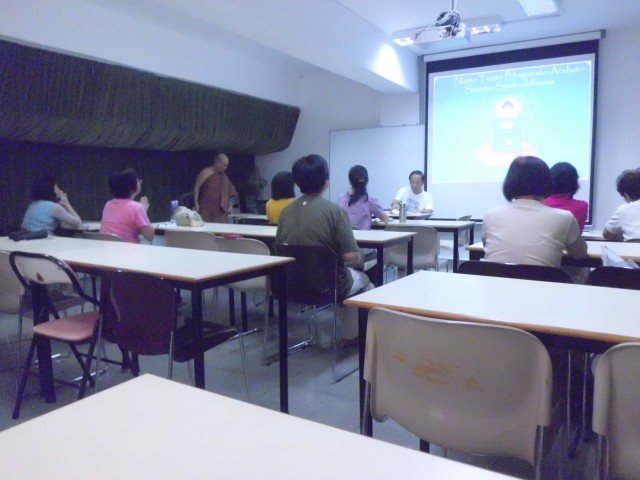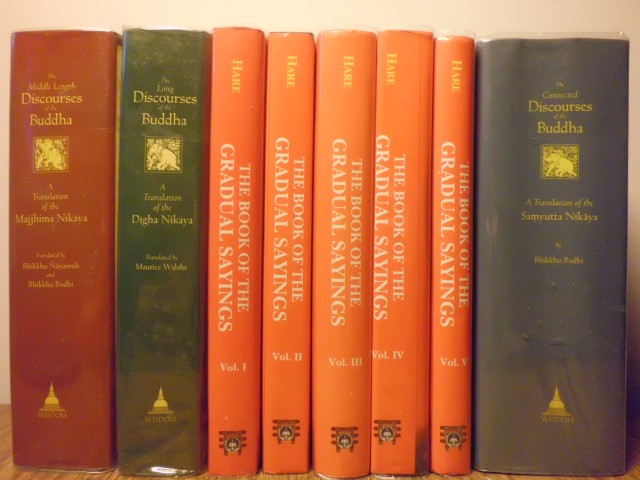The Sutta Studies Class for 2012 commenced on 3rd March led by Bhante Raja and with Brother Raymond Yow as moderator.

Brother Raymond Yow, the moderator set in motion the commencement of the class
Suttas or discourses were delivered by the Buddha on various occasions for various persons with different temperament and mostly intended for the bhikkhus. Still, there are many discourses dealing with material and moral progress targeted towards the well-being of the laity.

Question on a moot point

Bhante Raja elucidates a point
An outline of the programme is as follows:
A Brief Introduction to the Tipitaka
What is Tipitaka?
Tipitaka is a Pali word which means “three baskets”.
The whole Teaching of the Buddha is collected in the three baskets.

The Three Baskets are:
1. Vinaya Pitaka (Basket of Discipline)
2. Sutta Pitaka (Basket of Discourses)
3. Abhidhamma Pitaka (Basket of Ultimate Doctrine)
Sutta Nikaya or Sutta Pitaka is the second of the Three Baskets which is made up of five collections or Nikayas.
So what are the Sutta Nikayas?
Sutta Pitaka consists of the following five Nikayas:
1. Digha Nikaya – Long Discourses
2. Majjhima Nikaya – Middle-length Discourses
3. Samyutta Nikaya – Connected Discourses
4. Anguttara Nikaya – Gradual Discourses
5. Khuddaka Nikaya – Smaller Collection
The last Collection, Khuddaka Nikaya consists of 15 books:-
1. Shorter Texts (Khuddaka Patha)
2. The Way Of Truth (Dhammapada)
3. Paeans of Joy (Udana)
4. “Thus said “ Discourses (Itivuttaka)
5. Collected Discourses (Sutta Nipata)
6. Stories of Celestial Mansions (Vimana Vatthu)
7. Stories of Petas (Peta Vatthu)
8. Psalms of the Brethren (Theragatha)
9. Psalms of the Sister (Therigatha)
10. Birth Stories of the Bodhisatta (Jataka)
11. Exposition (Niddesa)
12. Book on Analytical knowledge (Patisambhidamagga)
13. Lives of Arahants ( Apadana)
14. History of the Buddha (Buddhavamsa)
15. Modes of Conduct (Cariya Pitaka)
About SUTTA NIKAYA or SUTTA PITAKA
What is the meaning of Nikaya or Pitaka?
Nikaya means collection, Pitaka means basket.
Therefore Nikaya or Pitaka means a collection of Suttas or a basket of Suttas.
They are same in meaning different in words.
In the first four Nikayas there are altogether 11,867 Suttas.
1. Digha Nikaya – 34 Suttas
2. Majjhima Nikaya – 152 Suttas
3. Samyutta Nikaya – 2904 Suttas
4. Anguttara Nikaya – 8777 Suttas

The 4 Nikayas
There are two ways we can learn the Sutta Nikayas:-
1. By General Topics –
Sutta Reading
(January – May)
2. By Specific Topics-
Dhammanupassana Workshop
(July – October)
What is Sutta Reading?
In Sutta Reading everyone will get a chance;
– to read
– to share
– and discuss
various selected Suttas from the 4 Nikayas.
The Objective of Sutta Reading
To go more in-depth
To practise accordingly
To encourage
To promote and propagate
To prevent being led astray by others
To dispel wrong views and wrong teachings
To support Buddhasasana so that it will be long lasting
To benefit others
To take Buddha as our only Teacher.
In Anguttara Nikaya, Dhammavihari Sutta,
Buddha praises one who is “Dhammavihari”
Dhammavihari means a practitioner of the Dhamma.
And how is one called a Dhammavihari?
One who is called a Dhammavihari should:-
1. Study the Sutta,
2. Reflect on it,
3. Chant them regularly,
4. Practise it
5. Teach them to others.
So how should we approach Sutta Study?
The approach to the Sutta Study is based on five points:-
1. Learn or study the Sutta
2. Reflect on the Sutta
3. Memorise (Recitation/Chanting) the Sutta
4. Practise according to the Sutta
5. Teach or share the Sutta with others
OUR MOTTO
LEARN THE SUTTA
REFLECT ON THE SUTTA
MEMORISE THE SUTTA (BY RECITATION)
PRACTISE WHAT IS BEING TAUGHT IN THE SUTTA
TEACH OR SHARE THE SUTTA WITH OTHERS
How Sutta is being Selected?
The 10,000 over suttas in the 4 Nikayas may be categorised broadly as:
1. Some suttas is for Chanting
2. Some sutta is for Practice
3. Some sutta is for both Chanting & Practice
4. Some suttas have the same pattern of presentation but different only in words.
5. Some suttas which appeal to some, may not be so to others, as it depends on every individual’s temperament and mentality.
Sutta is being selected on particular topic.
Compiled by: Chin Kee Thou



